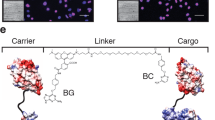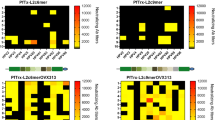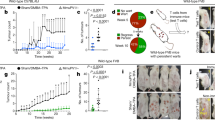Abstract
In order to test the immune response generated to small amounts of foreign protein in skin, we applied naked DNA in aqueous solution to untreated normal skin. Topical application of plasmid expression vectors for lacZ and the hepatitis B surface antigen (HBsAg) to intact skin induced antigen-specific immune responses that displayed TH2 features. For HBsAg, specific antibody and cellular responses were induced to the same order of magnitude as those produced by intramuscular injection of the commercially available recombinant HBsAg polypeptide vaccine. Finally, topical gene transfer was dependent on the presence of normal hair follicles.
This is a preview of subscription content, access via your institution
Access options
Subscribe to this journal
Receive 12 print issues and online access
$209.00 per year
only $17.42 per issue
Buy this article
- Purchase on Springer Link
- Instant access to full article PDF
Prices may be subject to local taxes which are calculated during checkout



Similar content being viewed by others
References
Donnelly, J.J., Ulmer, J.B., Shiver, J.W. & Liu, M.A. DNA vaccines. Annu Rev Immunol. 15, 617– 648 (1997).
Beard, C.W. & Mason, P.W. Out on the farm with DNA vaccines. Nat. Biotechnol. 16, 1325– 1328 (1998).
Barry, M.A. & Johnston, S.A. Biological features of genetic immunization. Vaccine 15, 788– 791 (1997).
Wang, R. et al. Induction of antigen-specific cytotoxic T lymphocytes in humans by malaria DNA vaccine. Science. 282, 476– 480 (1998).
Zierhut, M. et al. Immunology of the skin and the eye. Immunol. Today. 17, 448–450 (1996).
Tuting, T., Storkus, W.J. & Falo, L.D. Jr., DNA immunization targeting the skin: molecular control of adaptive immunity. J. Invest. Dermatol. 111, 183–188 (1998).
Lu, B., Federoff, H.J., Wang, Y., Goldsmith, L.A. & Scott, G. Topical application of viral vectors for epidermal gene transfer. J. Invest. Dermatol. 108, 803– 808 (1997).
Tang, D.C., Shi, Z. & Curiel, D.T. Vaccination onto bare skin [letter]. Nature 388, 729–730 ( 1997).
Davis, H.L. et al. CpG DNA is a potent enhancer of specific immunity in mice immunized with recombinant hepatitis B surface antigen. J. Immunol. 160, 870–876 (1998).
Berti, J.J. & Lipsky, J.J. Transcutaneous drug delivery: a practical review. Mayo Clin. Proc. 70, 581 –586 (1995).
Yu, W.H. et al. Topical gene delivery to murine skin. J. Invest. Dermatol. 112, 370–375 (1999).
Janda, J.M., Abbott, S.L. & Brenden, R.A. Overview of the etiology of wound infections with particular emphasis on community-acquired illnesses. Eur. J. Clin. Microbiol. Infect. Dis. 16, 189–201 (1997).
Li, L. . & Hoffman, R.M. The feasibility of targeted selective gene therapy of the hair follicle. Nat. Med. 1, 705–706 (1995).
Alexander, M.Y. & Akhurst, R.J. Liposome-medicated gene transfer and expression via the skin. Hum. Mol. Genet. 4, 2279–2285 (1995).
Lauer, A.C., Lieb, L.M., Ramachandran, C., Flynn, G.L. & Weiner, N.D. Transfollicular drug delivery. Pharm. Res. 12, 179–186 (1995).
Domashenko, A. & Cotsarelis, G. Transfection of human hair follicles using topical liposomes is optimal at the onset of anagen. J. Invest. Dermatol. 112, 552 (1999).
Livingston, B.D. et al. The hepatitis B virus-specific CTL responses induced in humans by lipopeptide vaccination are comparable to those elicited by acute viral infection. J. Immunol. 159, 1383– 1392 (1997).
Seitz, C.S., Lin, Q. Deng, H. & Khavari, P.A. Alterations in NF-κB function in transgenic epithelial tissue demonstrate a growth inhibitory role for NF-κB. Proc. Natl. Acad. Sci. USA 95, 2307–2312 (1998).
Acknowledgements
This work was supported by the Office of Research and Development, Department of Veterans Affairs (VA), by the National Institutes of Health, National Institute of Arthritis and Musculoskeletal and Skin Diseases (NIAMS) to P.A.K, and by the Herzog Foundation. H.F. is a recipient of an NIH postdoctoral training fellowship. We thank M. Kay for adenoviral vectors, X. He and H. Greenberg for HBsAg cDNA, and N. Griffiths and P. Bernstein for administrative support.
Author information
Authors and Affiliations
Corresponding author
Rights and permissions
About this article
Cite this article
Fan, H., Lin, Q., Morrissey, G. et al. Immunization via hair follicles by topical application of naked DNA to normal skin. Nat Biotechnol 17, 870–872 (1999). https://doi.org/10.1038/12856
Received:
Accepted:
Issue Date:
DOI: https://doi.org/10.1038/12856
This article is cited by
-
In vivo topical gene therapy for recessive dystrophic epidermolysis bullosa: a phase 1 and 2 trial
Nature Medicine (2022)
-
PDL2+ CD11b+ dermal dendritic cells capture topical antigen through hair follicles to prime LAP+ Tregs
Nature Communications (2018)
-
Combined skin and muscle vaccination differentially impact the quality of effector T cell functions: the CUTHIVAC-001 randomized trial
Scientific Reports (2017)
-
Strengthening the Skin with Topical Delivery of Keratinocyte Growth Factor-1 Using a Novel DNA Plasmid
Molecular Therapy (2014)
-
Progress Towards a Needle-Free Hepatitis B Vaccine
Pharmaceutical Research (2011)



